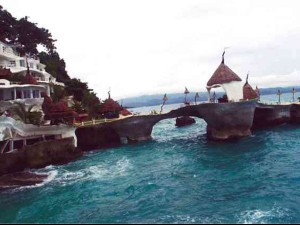
PORTIONS of Boracay West Cove allegedly constructed on a no-build zone. More than 200 other resorts and structures in the world-famous island have been found violating laws on buildings. NESTOR P. BURGOS JR./INQUIRER VISAYAS
ILOILO CITY—The government will spend P5 million of taxpayers’ money to demolish illegal structures of a privately owned posh resort on Boracay island.
Environment Secretary Ramon Paje has ordered the release of P4,830,000 to the local government of Malay in Aklan, which has jurisdiction over the popular island resort, to complete the demolition of the structures of the Boracay West Cove resort.
Ivene Reyes, provincial environment officer (Penro) of Aklan, said the fund would be released after the signing of a memorandum of agreement between the Department of Environment and Natural Resources (DENR) and the municipal government, and the submission of a program of work and financial plan.
Reyes said the remaining P170,000 would be allotted for the monitoring and supervision of the demolition.
Asked why government would spend public funds for the demolition of an illegal structure of a privately owned business, Reyes said this is to fast-track the removal of the illegal structures in the resort.
“We cannot expect the owner, who insists on the legality of his resort, to voluntarily dismantle the illegal structures soon. It would take a long time if we wait,” Reyes said.
But the environmental group Madia-as Ecological Movement (MEM) decried the use of public funds for the demolition.
“Why are the people being made to shoulder the removal of illegal structures when these are, in the first place, the result of the failure of government agencies and officials to do their jobs?” said MEM secretary general Ma. Geobelyn Lopez.
Upon orders of the DENR and the Department of the Interior and Local Government, the Malay municipal government started the demolition of illegal structures in the resort on July 19, 2012. The demolition team, backed by policemen, dismantled the structures that were in violation of building and environmental laws.
The agencies ordered the demolition of illegal structures and closure of the resort for violation of the Forest Land Use Agreement for Tourism Purposes, or FLAgT, issued by the DENR to the resort in 2009 during the term of then Environment Secretary Jose Atienza.
The DENR Environmental Management Bureau in Western Visayas said the resort constructed permanent structures in an area covering 3,159 square meters outside the 998-sq m area covered by the FLAgT.
A FLAgT allows the temporary use, occupation and development of any forest land for tourism purposes for a period of 25 years renewable for another 25 years. The resort was also ordered closed for operating without business, building and mayor’s permits.
West Cove became controversial for building structures on natural rock formations and operating for years without permits.
But the resort continues to operate because of a pending case in the Court of Appeals against a closure order issued by the Malay municipal government on June 7, 2011, for lack of business, building and occupancy permits.
West Cove owner Crisostomo Aquino has repeatedly insisted that he did not violate the FLAgT and environmental laws. He said the local government has ignored his application for permits and accused the government agencies of singling out his resort.
Aquino said he was charged P600,000 by the municipal government for expenses in last year’s demolition of structures at his resort, half of which he has already paid.
“Before they conduct further demolitions, they should first conduct a survey on the boundaries of the FLAgT because, as far as I am concerned, they have nothing to demolish at my resort,” Aquino told the Inquirer.
The demolition of illegal structures of the resort was not completed because of the high costs, according to municipal Councilor Rowen Aguirre.
At least 293 resorts, houses and government structures in Boracay have been found to be violating easement and building laws, according to Reyes.

